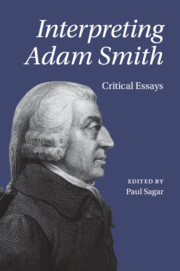Book contents
- Interpreting Adam Smith
- Interpreting Adam Smith
- Copyright page
- Contents
- Contributors
- Acknowledgements
- Abbreviations of Works by Adam Smith
- Introduction
- 1 Smith Scholarship
- 2 The Wealth of Nations as a Work of Social Science
- 3 Adam Smith’s “Industrial Organization” of Religion
- 4 Talking to My Butcher
- 5 What Did Adam Smith Mean? The Semantics of the Opening Key Principles in the Wealth of Nations
- 6 Adam Smith and Virtuous Business
- 7 Adam Smith and the Morality of Political Economy
- 8 A Moral Philosophy for Commercial Society?
- 9 Adam Smith, Sufficientarian
- 10 Narrowing the Scope of Resentment in Smith’s Theory of Moral Sentiments
- 11 Adam Smith
- 12 “Much Better Instructors”
- 13 Sophie de Grouchy as an Activist Interpreter of Adam Smith
- 14 Adam Smith and the Limits of Philosophy
- Bibliography
- Index
10 - Narrowing the Scope of Resentment in Smith’s Theory of Moral Sentiments
Published online by Cambridge University Press: 14 September 2023
- Interpreting Adam Smith
- Interpreting Adam Smith
- Copyright page
- Contents
- Contributors
- Acknowledgements
- Abbreviations of Works by Adam Smith
- Introduction
- 1 Smith Scholarship
- 2 The Wealth of Nations as a Work of Social Science
- 3 Adam Smith’s “Industrial Organization” of Religion
- 4 Talking to My Butcher
- 5 What Did Adam Smith Mean? The Semantics of the Opening Key Principles in the Wealth of Nations
- 6 Adam Smith and Virtuous Business
- 7 Adam Smith and the Morality of Political Economy
- 8 A Moral Philosophy for Commercial Society?
- 9 Adam Smith, Sufficientarian
- 10 Narrowing the Scope of Resentment in Smith’s Theory of Moral Sentiments
- 11 Adam Smith
- 12 “Much Better Instructors”
- 13 Sophie de Grouchy as an Activist Interpreter of Adam Smith
- 14 Adam Smith and the Limits of Philosophy
- Bibliography
- Index
Summary
For Adam Smith, resentment is the natural passion we feel at experiencing or witnessing injustice and the basis for our natural sense of justice. Why does Smith restrict justifiable resentment to injustice given his seeming admission that we do naturally feel resentment beyond the case of injury? Smith never directly addresses why such resentments are inappropriate in The Theory of Moral Sentiments; we reconstruct a response drawn from his moral psychology. First, we explain the origins of Smith’s narrow view of justice. We then turn to Smith’s account of resentment, explaining its purpose as the natural motive for narrow justice, questioning the split between descriptive and normative resentment. We ultimately argue that resentment’s logical tie to punishment for Smith is necessary but insufficient, and that injury and resentment are separate conditions required to justify punishment. Finally, we reconstruct Smith’s normative justifications for severing the tie between improper resentments and punishment, driven by his claims about equal status and about sociability.
Information
- Type
- Chapter
- Information
- Interpreting Adam SmithCritical Essays, pp. 160 - 176Publisher: Cambridge University PressPrint publication year: 2023
